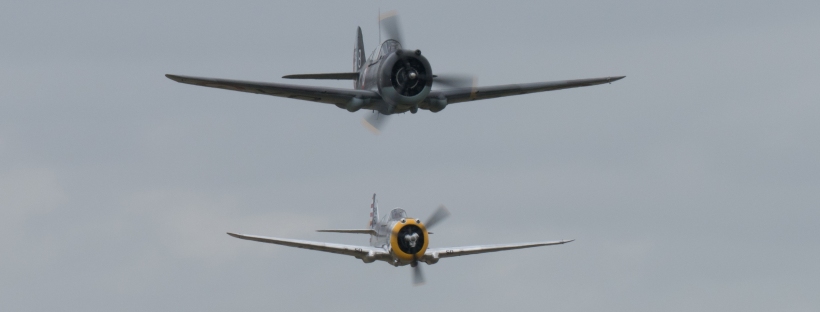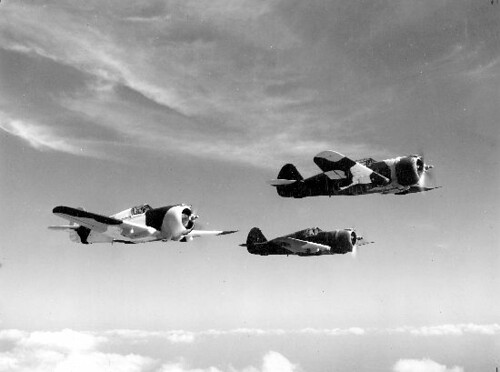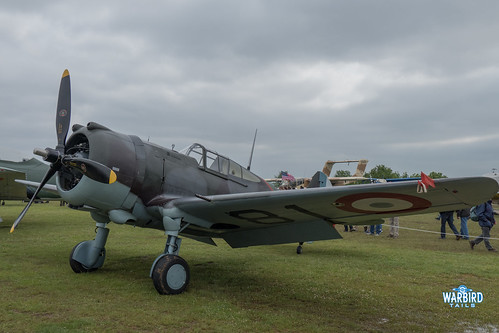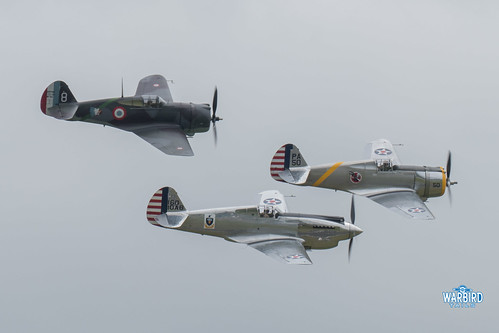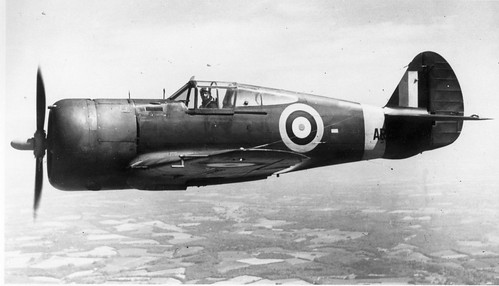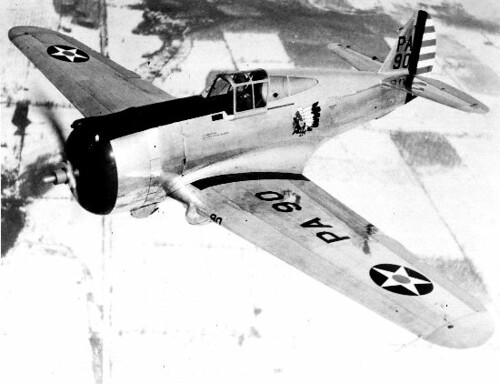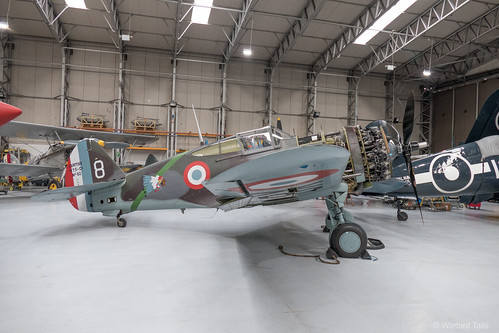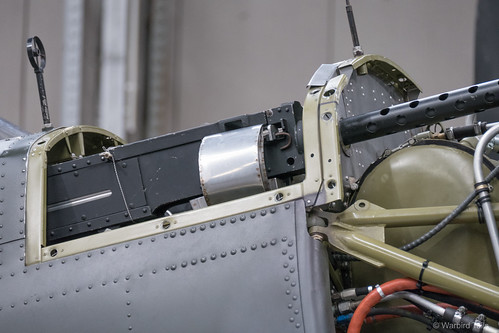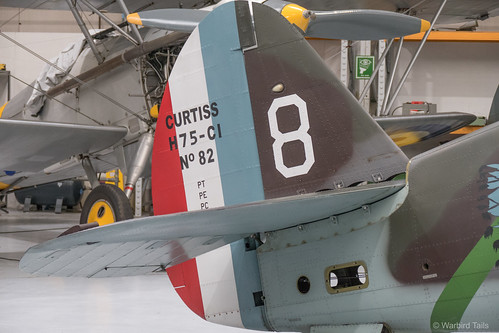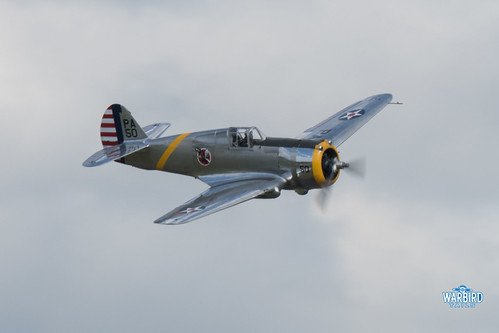Moving on from the Biplane Hawks and racers covered in the last post in this series it is now time to take a look at Curtiss’ first monoplane fighter to make a mark in the Second World War, the P-36.
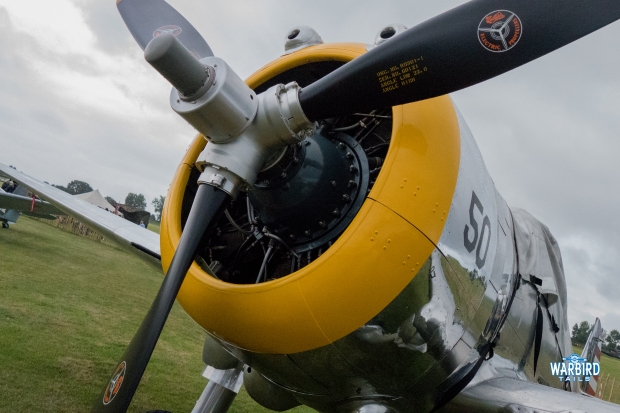
Development
This stocky fighter first took to the skies in 1935 and while a Curtiss product it actually contained many elements of other manufacturers designs. The Model 75, as it was originally known was started as a private venture with the Northrop Company. Interestingly the characteristic landing gear mechanism, something which has become unmistakably Curtiss, was actually previously patented by Boeing.
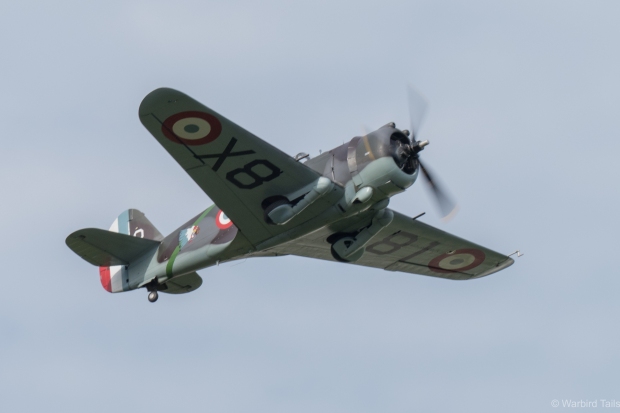
This new generation Hawk boasted all metal construction and a 900hp Wright radial engine, pushing this new design to 281mph on its first flight in May 1935. Within a month of taking to the skies the 75 was already set to take part in the single seat fighter trials at Wright Field. By the time the test began Curtiss had changed power plant, now making use of a 950hp Wright Cyclone.
The competition was delayed by 11 months and did not take place until April 1935, technical problems led to a disappointing event for Curtiss, ultimately loosing out to the Seversky P-35. However the changing mood in Europe led to the US Army Air Force erring on the side of caution and they elected to order the Curtiss entry as well to ensure sufficient cover should it be required. This saw another version of the 75 unveiled as part of the 1937 competition which led to 210 P-36A’s being ordered.
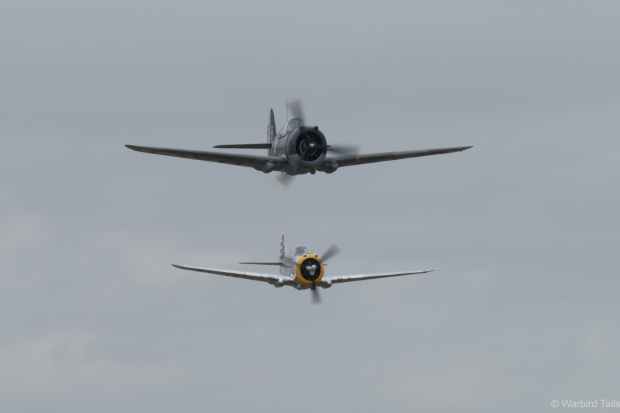
Operational History
The Hawk saw most of its active service with the French Air Force who flew the Hawk 75 export model. A full post outlining the types operational history in the early years of the war in France will soon follow, safe to say that the Curtiss fighrer held its own against the BF109s during those early war years, considering the differnce in technology.
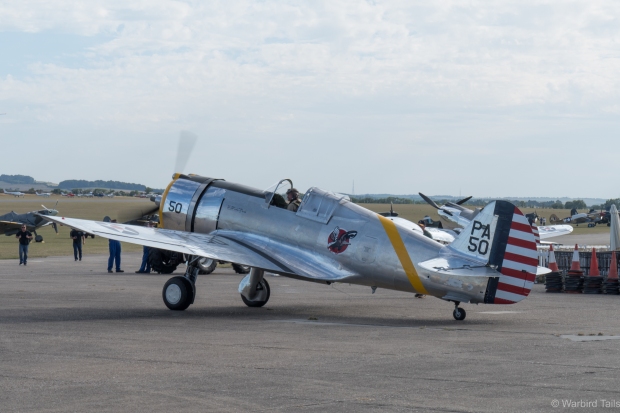
These Hawk 75 export models eventually found their way to the United Kingdom with the Royal Air Force borrowing an example for evaluation purposes. The main trial took place in 1939 and saw the Hawk pitted against the Spitfire Mk I and Gloster F5 (a unique type which will form the subject of another upcoming Warbird Tails post). The Hawk was found to be superior to the Supermarine fighter in a number of ways, specifically requiring far less force on the controls at high speed.
As the situation in France worsened the planned deliveries to mainland Europe were diverted and the RAF suddenly found themselves in possession of over 200 Hawks, these would become known as Mohawks in RAF service. Many of these Mohawks served in the Royal Indian Air Force carrying out bomber escort and ground attack duties before the type was formally retired from the RAF in 1944.
Another European operator of note was the Finnish Air Force, which purchased around 50 captured examples of the type from Germany shortly after the Battle of France ended, they used these airframes in combat against the Russian Air Force.
Back home in the United States the Hawk saw limited service. Early examples were plagued with problems which led to the type quickly being viewed as obsolete by the US Army Air Force. Many were relegated to Hawaii. The delivery to the islands was unusual in that the Hawks were flown off the deck of the US Carrier USS Enterprise. In a twist of fate these “obsolete” fighters actually saw the first aerial combat of the war for an American aircraft. Five P-36As were launched to combat the Japanese attack on the 7th December 1941 and claimed two Zeros for the loss of one P-36. This would be the only active service the P-36 saw with the US Army Air Force.
A number of fixed undercarriage variants of the Hawk 75 were also built for export duties, notably seeing service with the Argentinian military up until 1954 and originally sold to China. These fixed gear variants were known as 75H models.
The tale of the P-36 is certainly that of an underdog, it was another example of the familiar tale of being caught between two ages. Like many other aircraft of the time it bridged that gap between Biplane and the classic Monoplane fighters we would soon see. Nevertheless the little Hawk saw some success in Europe and provided some defence for America on the day it entered the war. While not anyones first choice during the early days of the war the Hawk certainly stood up to the mark and proved itself a contender. The fact that really stands out is just how far this basic airframe design would go. The Hawk wing was built with speed in mind, speed that couldn’t be achieved with the power available at the time. The p-36 airframe would soon be used as the genesis of the P-40 line, Curtiss’ most famous child and though an underdog again, another iconic aircraft of the Second World War.
From the Cockpit
For this section of the post I have drawn pilots impressions from the National Archive records of the Hawk as part of the RAF evaluation in 1939.
Initial impressions at the time, gathered on a visit to France found that the aircraft was “exceptionally easy and pleasant to fly, the aileron control being particularly powerful” – Curtiss ailerons maintained a great reputation throughout the P-40 lineage of course. Interestingly, one of the reasons the Hawk was included in this test was that there were increasing concerns over the ailerons in the Spitfire becoming heavy at speed, to an extent they were almost impossible to move over 300mph.
Once at Boscombe Down, the Air Force set about high speed testing of the Curtiss fighter. The thoughts and comments below stem from the findings of the Aerodynamics flight between 29th December 1939 and 13th January 1940, when the Hawk was leant to the RAF.
Take off was said to be straightforward, with any tendency to swing to the left easily corrected using rudder and the aircraft accelerates well. All the controls are responsive once in the air and initial climb rate is good.
The stall figures for the Hawk make interesting reading, with gear and flaps down the wing keeps flying until 65mph, while the cleaned up stall arrives at 75mph. It is noted that right up until the stall the controls remain effective after which a wing will drop and the nose will follow, though this can be easily corrected. The stall is less severe when the gear and flaps are up.
As well as having very powerful ailerons the Hawk boasted well harmonised controls, though there is little need for much use of the rudder in normal flight. As discovered in France the controls have no tendency to become heavy at high speed.
High speed research was the main purpose of the Air Force borrowing the Curtiss and it was dived up to 400mph during the course of the test with no concerning results noted.
Once a flight is over the gear and flaps result in a tendency for the nose to drop but it is easy to maintain a speed of 100mph and the controls retain their effectiveness even at low speed. The Hawk can happily manoeuvre at 85mph without any tendency to stall or any reduction is control response. A speed of around 80-85mph is required on finals and the aircraft settles calmly on to the runway. The only note of caution in the report is not to raise the flaps too early during a go-around as this results in the nose lifting quickly.
One last point of note is the cockpit itself, this was found to be much more spacious than the fighters the British pilots were used to, not uncommon with American designs. There was also the challenge of the throttle working in the opposite way to tradition (fully forward for idle and fully back for full power), something which the test pilots apparently became accustomed to quickly!
Further Development
The P-36 design had always been conceived with development in mind, the basic airframe and the wing in particular were capable of much more than the power plants available could provide. Curtiss attempted to progress the P-36 further by attaching an Alison V-1710-21 to the front of a P-36 airframe. This lengthened nose, combined with the severe re-positioning of the cockpit led to the “unique” looking XP-37. The new prototype was tested extensively but issues with visibility unsurprisingly became apparent with issues both on the ground and in the air. The new design did see an improvement in top speed over the P-36, clocking in at 340mph.
Ultimately the issues with the design outweighed the increased performance and only one example was ever constructed. Curtiss had proven a point with their test fitting of an Alison to their design however. The next attempt to marry the P-36 airframe with an Alison engine would turn out much better.
Survivors
Airworthy Examples
For a relatively unsung and unknown predecessor to the P-40, the P-36/H75 line of aircraft has made an unexpected impression on the UK airshow circuit. Stephen Grey has been responsible for brining two stunning examples of this classic fighter back to life and to the UK skies.
Hawk 75 – No.82/G-CCVH
Now a resident and regular Duxford performer for over a decade, Hawk 75 No.82 was the first of the Fighter Collection’s pair of Hawks to take to the skies. This aircraft was part of the first batch of Hawks to be delivered to France in 1939.
After arriving in france ’82 joined the 11/5 Combat Group becoming the personal aircraft of Commandant Murtin. With the Battle of France over, this aircraft saw out the remainder of the war in North Africa and served as a trainer from 1946 to 1949. Amazingly this airframe escaped being scrapped once the French stopped flying these aircraft and The Fighter Collection acquired the airframe in 1995. The Hawk was then the subject of an extensive restoration project resulting in one of the worlds most significant warbirds.
I must admit to being unaware of the Hawk until this airframe arrived at Duxford but I have always had a particular fascination with the type and it has led to my overall interest in the Curtiss lineage. There is something about this pre-war monoplane design that really strikes a chord. It was especially poignant to see the aircraft perform a graceful solo display in France in the hands of a Frenchman at La Ferté-Alais in 2016, an event at which the Hawk has performed regularly at since returning to flight.
P-36C – 38-210/G-CIXJ
Joining the Fighter Collection’s fleet at Duxford in 2015 was the second Model 75, this time in the form of a P-36C, believed to be the final P-36 off the production line. The airframe was built in 1939 and famously participated in an alternative camouflage trial at the Cleveland air races of the same year (pictured below). The aircraft spent time with a number of USAAC squadrons during the early years of the war before joining Chanute Technical Training Command in 1942.
The airframe was only with the Training Command for a few months before being declared obsolete and was eventually acquired by a Canadian owner. The Fighter Collection acquired the project and restoration started in the early 2010s resulting in an unexpected roll-out at the 2015 Planes of Fame airshow at Chino.
P-36 survivors were considered to all be accounted for and certainly known to be rare sights so seeing the news appear online of another airworthy Hawk in May 2015 was incredible. Though unannounced at the time, it seemed obvious that the new Hawk would be on its way to Duxford before long, given the Fighter Collection’s history of returning rare Curtiss fighters back to former glory. Sure enough the airframe was shipped over to Duxford later in the year and made its Flying Legends debut in July 2015. An incredible sight that seemed to pass many UK enthusiasts by was what must have been the first appearance of two P-36/H75 aircraft in the sky together.
The airframe has since been placed on the UK register and performed again at the 2016 Flying Legends display as well as a static appearance in the Freddie Marsh Spirit Of Aviation event at Goodwood in September. Alongside the immaculate P-40C and Hawk 75 the P-36 is one of the worlds most impressive restoration projects and I look forward to seeing more of this machine in the future.
Static Survivors
While the airworthy aircraft based at Duxford currently make up 50% of the Hawk 75/P-36 survivors, two other complete airframes exist along with a further restoration project ongoing in New Zealand.
Hawk 75N – Thai Air Force Museum – Bangkok
Little is known of the history of this particular airframe, other than it is the only remaining example of a fixed with Hawk 75, the N model was a specifically simplified version of the design for the Thai Air Force, this unknown airframe is on display in a fully restored condition.
P-36A – 38-001 – National Museum of the United States Air Force – Dayton
This airframe is the first P-36 delivered to the US military and currently wears the markings of one of the aircraft that took part in the response to the Pearl Harbour attacks. (Image source)
Conclusion
An important chapter in the history of Curtiss aviation then, the P-36 lead to the P-40, arguably Curtiss’ best known aircraft and like so many mid 30s designs did the job in the early days of war when more modern aircraft were harder to come by. I hope that by the end of this post you may understand a little of why I favour these Curtiss fighters so much. The sight of the two airworthy examples performing at Duxford is something to be cherished and ceratinly something that should not be taken for granted.While the P-40 may have taken much of the Curtiss wartime glory, it would not have come into existence has it not been for this rugged radial fighter.
All images in this post are copyright Warbird Tails where marked, archive shots are from the San Diego Air and Space Museum archive or credited accordingly.
